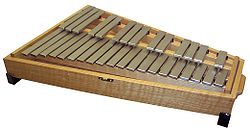Glockenspiel
 A glockenspiel made by Malletech | |
| Percussion instrument | |
|---|---|
| Other names |
|
| Classification |
Keyboard percussion |
| Hornbostel–Sachs classification | 111.222 (Sets of percussion plaques) |
| Playing range | |
 | |
| Related instruments | |
The glockenspiel (
The glockenspiel is played by striking the bars with mallets, often made of a hard material such as metal or plastic. Its clear, high-pitched tone is often heard in orchestras, wind ensembles, marching bands, and in popular music.
Terminology
In German, a carillon is also called a Glockenspiel, and in French, the glockenspiel is sometimes called a carillon. It may also be called a jeu de timbres (lit. 'set of small bells') in French, although this term may sometimes be specifically reserved for the keyboard glockenspiel.[1] In Italian, the term campanelli (lit. 'little bells') is used.[2]
The glockenspiel is sometimes erroneously referred to as a xylophone. (The xylophone has wooden bars, unlike the glockenspiel which has metal bars.)[3] The Pixiphone, a type of toy glockenspiel, was one such instrument sold as a xylophone.
Range
The glockenspiel is limited to the upper
History

Early glockenspiels were percussion instruments that produced notes via small bronze
Construction

When used in a marching or military band, the bars are sometimes mounted in a portable case and held vertically, sometimes in a lyre-shaped frame. However, the bars may be held horizontally, using a harness similar to that found on a marching snare. In orchestral use, the bars are mounted horizontally.
Larger sets of glockenspiel (i.e., sets three octaves or larger) are often equipped with a sustain pedal, not unlike that of a vibraphone.[8]
From 1918 to 1932, J.C. Deagan, Inc. manufactured bells equipped with a resonator under the name Parsifal bells.[9] Both Adams and Yamaha model their professional-grade glockenspiels on the Deagan design.[10]
Mallets
The glockenspiel is played with unwrapped
Bell-lyre

In the United Kingdom, the United States, and Canada, a form of glockenspiel is called a bell lyre, bell lyra, or lyra-glockenspiel.[11] The bell lyre is a form of glockenspiel commonly used in marching bands.[12]
One variation is played vertically and has an extendable spike that is held on a strap. The player marches with the strap over one's shoulder and plays the instrument upright with a mallet. Another variation of the bell lyre exists that is supported by a strap around the shoulders and back. This variation is played horizontally with two mallets. Since the middle of the 19th century this form has been used in military and civil bands in Germany, where it is called a Stahlspiel or Militär-Glockenspiel.
The all-percussion drum and lyre corps in the Philippines uses this as a main instrument. This form of glockenspiel is also popular in Colombian marching band music.[13]
Many marching bands stopped using bell lyres with the introduction of the front ensemble. One of the few college marching bands with a glockenspiel section is UC Berkeley's University of California Marching Band, where they are affectionately referred to as "glocks".[14]
See also
References
- OCLC 10561390.
- ^ Beck 2014, p. 121.
- ^ Desiderio, Kelsey (13 July 2015). "You Know More Now: Xylophone Vs. glockenspiel". MSNBC. Retrieved 12 November 2022.
- OCLC 900827870.
- OCLC 4589.
- OCLC 28230162.
- ^ "glockenspiel." The New Penguin Dictionary of Music, Paul Griffiths, Penguin, 1st edition, 2006. Credo Reference. Accessed 19 Jan. 2022.
- ^ "Brief Description – Vienna Symphonic Library". www.vsl.co.at. Retrieved 25 May 2021.
- ^ Beck 2014, p. 67.
- OCLC 1100674819.
- ISBN 978-1-56159-239-5.
- ^ glockenspiel at the Encyclopædia Britannica Retrieved 19 January 2022.
- ^ "Banda de Guerra". Fuerza Aérea Colombiana (in Spanish). Archived from the original on 20 June 2021. Retrieved 16 July 2020.
- ^ Chen, Jeremy (27 January 2013). "Glocks, Oboes and Violins? Oh, My!". Halftime Magazine.
Bibliography
- Beck, John H. (2014). Encyclopedia of Percussion (2nd ed.). Routledge. OCLC 939052116.
External links
 Media related to Glockenspiels at Wikimedia Commons
Media related to Glockenspiels at Wikimedia Commons- . Encyclopædia Britannica. Vol. 11 (11th ed.). 1911.
- "Glockenspiel Excerpts from The Sorcerer's Apprentice" performed by William James of the St. Louis Symphony Orchestra

